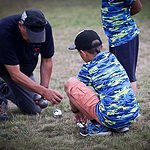Understanding the difference between understable and overstable discs can elevate your disc golf game. Overstable discs resist turning right, offering predictable left finishes—perfect for maneuvering tight courses and windy conditions. They’re ideal for experienced players who require precision. In contrast, understable discs turn right during high-speed throws, making them forgiving and easier for beginners, allowing longer flights with less arm speed. They shine in tailwinds, enabling control over unique flight paths. Each type has its role, and knowing when to use them can greatly impact your performance. Explore further to uncover more tips and techniques for disc selection!
Understanding Disc Stability
When you step onto the disc golf course, understanding disc stability can greatly enhance your gameplay. The stability of your disc directly influences its flight behavior, impacting how you approach each throw. Overstable discs resist turning right during high-speed flight and feature a strong leftward fade, making them reliable in windy conditions. If you need predictability and control, overstable discs are your go-to choice.
On the other hand, understable discs tend to turn right during high-speed flight, making them an excellent choice for beginners looking to achieve longer and straighter shots. They typically show little to no fade, allowing for a smooth and manageable flight path, essential for developing your skills.
The flight rating system can help you analyze disc stability further. By evaluating speed, glide, turn, and fade, you can tailor your disc selection to match your unique throwing style and the course’s demands.
Flight Ratings Explained
Understanding flight ratings is essential for any disc golfer aiming to improve their game.
These ratings break down a disc’s performance into four key numbers: Speed, Glide, Turn, and Fade (S/G/T/F). The Speed rating, ranging from 1 to 15, tells you how fast a disc can fly, while the Glide rating, from 1 to 7, measures its ability to maintain height and distance.
The Turn rating, which spans from +1 to -5, is particularly important when considering overstable vs understable discs. A higher negative Turn rating means the disc will turn more to the right during a high-speed throw for right-handed backhand throwers, making it more understable.
Conversely, a Turn rating closer to +1 indicates resistance to turning, making the disc more overstable.
Characteristics of Understable Discs
The characteristics of understable discs play a considerable role in how you approach your throws on the course. These discs are designed to turn to the right during high-speed flight for right-hand backhand (RHBH) throws, making them perfect for achieving longer, straighter shots with minimal fade. With a turn rating of -1 or lower, understable discs offer a unique flight path that caters to both beginners and seasoned players alike.
For beginners, the forgiving flight characteristics of understable discs mean you don’t need to generate a lot of arm speed to reach your desired distance. This accessibility encourages you to experiment with advanced techniques like hyzer flips and anhyzer shots, allowing you to shape your throws and navigate obstacles more effectively.
Additionally, environmental factors such as tailwinds can greatly enhance the performance of understable discs, helping you gain extra distance and achieve those right-turn shots you desire.
Characteristics of Overstable Discs
Overstable discs serve as a reliable ally for disc golfers seeking precision and control in their throws. These discs boast unique flight characteristics that make them a go-to choice for experienced players.
When you throw an overstable disc, you’ll notice it resists turning during high-speed flight, typically exhibiting minimal rightward turn for right-handed backhand (RHBH) throws. As the disc decelerates, it tends to fade considerably to the left, providing predictability and allowing for a controlled landing angle.
With lower turn ratings, generally between 0 to -1, overstable discs remain stable throughout their flight. This stability shines in windy conditions, where they deliver consistent performance against headwinds that could easily destabilize other disc types.
Disc golfers often leverage overstable discs for specific techniques, such as flex shots, where the disc initially turns before confidently returning to the left for a strong finish.
When to Use Overstable Discs
When should you reach for an overstable disc? The answer lies in specific game situations where you need reliability and predictability.
Overstable discs excel when you’re throwing into a headwind. Their resistance to turning means they maintain a consistent flight path, essential for maneuvering challenging conditions.
If you’re looking to execute a flex shot, overstable discs can help you turn right during the flight before they inevitably fade at the end. This quality makes them perfect for tight fairways or tricky approaches where precision is important.
Additionally, if you’re playing in windy areas, these discs come with high fade ratings, ensuring they finish left of your target for right-handed backhand throwers.
This predictability allows you to plan your shots effectively, giving you the freedom to focus on your technique rather than worrying about unexpected turns.
When to Use Understable Discs
In certain situations on the course, reaching for an understable disc can elevate your gameplay, especially if you’re just starting out. Understable discs are fantastic for beginners because they require less arm speed, allowing you to achieve straight and extended flight paths with ease.
When you’re throwing an understable disc, you’ll find it particularly useful for executing right-turning shots on right-hand backhand throws. This opens up the possibility for graceful anhyzer throws and effective hyzer flips.
If you find yourself in tailwind conditions, don’t hesitate to grab an understable disc. It gains additional stability and distance, making those longer throws feel effortless. You can also throw these discs with a hyzer angle to achieve a late right turn, helping you navigate around obstacles or make sharp turns mid-flight.
For experienced players, understable discs offer advanced techniques like backhand rollers or S-curves. This versatility in shot shaping keeps your game dynamic and unpredictable, allowing you to explore various strategies on the course.
Embrace the freedom that comes with mastering understable discs, and watch your skills flourish.
Popular Understable Discs
Among the many options available, several understable discs stand out for their remarkable flight characteristics and versatility. These discs are perfect for players looking to enhance their game, especially beginners or those with lower arm speeds. They typically feature higher turn ratings, allowing for impressive turnover shots and hyzer-flip techniques.
Here’s a quick look at some popular understable discs you might want to try:
| Disc Name | Turn Rating | Fade Rating |
|---|---|---|
| Innova Leopard | -2 | 2 |
| Discraft Buzzz SS | -3 | 1 |
| Dynamic Discs Diamond | -4 | 1 |
These understable discs enable smooth, extended flight paths with little to no fade at the end, giving you the ability to cover significant distances. They excel in tailwind conditions, where their natural turn helps maintain stability. Plus, lighter molds are great for beginners, allowing you to enjoy the learning process. Whether you’re practicing or playing a round, these discs can enhance your overall experience and improve your skills on the course. Embrace the freedom they offer!
Popular Overstable Discs
Overstable discs are essential tools for disc golfers seeking precision and reliability in their throws. These discs are designed to resist turning right, ensuring a consistent flight path that ends with a strong leftward fade.
Here are four popular overstable discs you might want to evaluate:
Innova Firebird: Known for its reliable fade and durability, it’s perfect for hyzer throws and flex shots.
Discraft Buzzz OS: A favorite among advanced players, this disc offers a stable flight with minimal turn, ideal for windy conditions.
Dynamic Discs Justice: This disc is renowned for its extreme over-stability, making it a go-to for headwinds and downhill throws.
MVP Switch: With a low turn and high fade, it provides a predictable flight that can handle various throwing speeds.
Choosing the right overstable disc not only enhances your performance but also gives you the freedom to tackle challenging courses with confidence.
Whether you’re facing unpredictable winds or need that strong left finish, these discs are your reliable allies on the course.
Factors Affecting Stability
Choosing the right overstable disc is just one part of mastering your game; understanding the factors that affect a disc’s stability is equally important. Stability isn’t just about the disc’s design; several physical attributes play an essential role.
For instance, rim width greatly influences flight characteristics; wider rims generally result in more overstable performance. The Parting Line Height (PLH) also plays a key role; a higher PLH can enhance durability and lessen the tendency for the disc to lose stability over time.
Environmental factors shouldn’t be overlooked either. At higher elevations, discs can become more overstable due to reduced air pressure.
Additionally, the type of plastic affects both durability and stability. Premium plastics often provide a more consistent performance compared to standard materials, making them a solid choice for serious players.
Finally, wear and tear can impact your disc’s flight; nicks and scratches can lead to increased understability, altering how it performs on the course.
Choosing the Right Disc
Selecting the right disc can feel like maneuvering through a maze, especially with so many options available. Understanding the stability rating of your discs is essential for enhancing your game.
Here are four key considerations to help you choose wisely:
Skill Level: As a beginner, start with understable discs. They’ll allow you to achieve longer, straighter flights, helping you build confidence.
Flight Rating: Familiarize yourself with the four-number flight rating system—Speed, Glide, Turn, and Fade. This will guide you in understanding how your chosen disc will behave during flight.
Wind Conditions: When facing headwinds, overstable discs are your best bet. They provide predictable left finishes, ensuring reliability when the wind kicks up.
Weight Matters: Consider the weight of your disc. Heavier discs offer increased stability, making them suitable for windy conditions, while lighter discs are easier to control for beginners.
Conclusion
Just like a skilled artist chooses the right brush for their canvas, selecting the right disc can transform your game. Understanding the nuances of understable and overstable discs empowers you to paint your perfect shot, regardless of the course or conditions. Whether you’re maneuvering tight fairways or battling the wind, knowing when to use each type will elevate your performance. Embrace these tools, and watch as your disc golf skills flourish, turning every round into a masterpiece.





